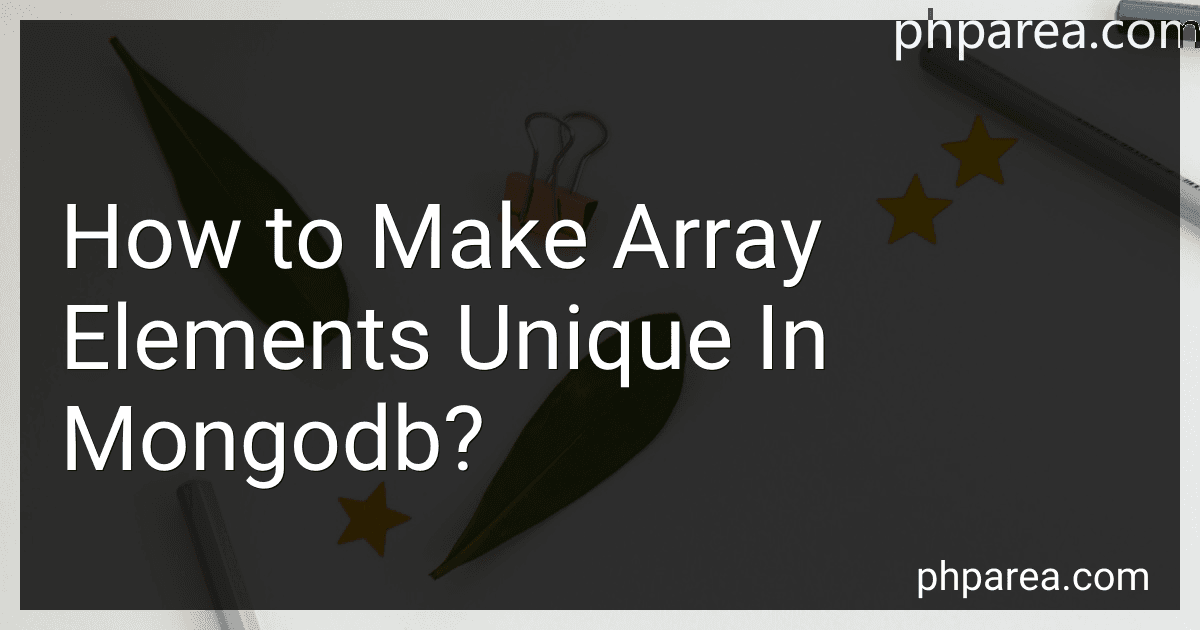Posts (page 6)
-
 11 min readTo update an array of objects in MongoDB, you can use the $set, $push, $pull, and $update operators within an update operation. The $set operator allows you to modify elements at specific positions within the array by using the dot notation to specify the index of the element. The $push operator adds new elements to the end of the array, while $pull removes elements that match a specified condition.
11 min readTo update an array of objects in MongoDB, you can use the $set, $push, $pull, and $update operators within an update operation. The $set operator allows you to modify elements at specific positions within the array by using the dot notation to specify the index of the element. The $push operator adds new elements to the end of the array, while $pull removes elements that match a specified condition.
-
 5 min readTo update an array of objects for multiple documents in MongoDB, you can use the $addToSet or $push operators in combination with the update method. First, you need to specify the criteria for selecting the documents to be updated using the find method. Then, you can use the update method to add or push new objects to the array field in the selected documents. Make sure to use the multi option to update multiple documents at once.
5 min readTo update an array of objects for multiple documents in MongoDB, you can use the $addToSet or $push operators in combination with the update method. First, you need to specify the criteria for selecting the documents to be updated using the find method. Then, you can use the update method to add or push new objects to the array field in the selected documents. Make sure to use the multi option to update multiple documents at once.
-
 5 min readTo fetch field names inside an array of collections in MongoDB, you can use the db.collection.distinct() method. This method returns an array of field names from all the documents in a collection. You can specify the field name you want to fetch within the distinct method as a parameter.For example, to fetch all the field names inside an array of collection called 'users', you can use the following query: db.users.
5 min readTo fetch field names inside an array of collections in MongoDB, you can use the db.collection.distinct() method. This method returns an array of field names from all the documents in a collection. You can specify the field name you want to fetch within the distinct method as a parameter.For example, to fetch all the field names inside an array of collection called 'users', you can use the following query: db.users.
-
 6 min readTo create a collection in a document in MongoDB, you first need to have a database created in which you want to store your collection. Once you have your database set up, you can use the db.createCollection() method in MongoDB to create a new collection within that database.You can specify the name of the collection that you want to create as a parameter in the createCollection() method.
6 min readTo create a collection in a document in MongoDB, you first need to have a database created in which you want to store your collection. Once you have your database set up, you can use the db.createCollection() method in MongoDB to create a new collection within that database.You can specify the name of the collection that you want to create as a parameter in the createCollection() method.
-
 6 min readTo aggregate two collections in MongoDB using $group, $lookup, and $match together, you can first use the $lookup stage to join the two collections based on a common field. Next, you can use the $match stage to filter the documents based on specified criteria. Finally, you can use the $group stage to group the documents together based on a specific field and perform aggregation functions such as counting, summing, or averaging.
6 min readTo aggregate two collections in MongoDB using $group, $lookup, and $match together, you can first use the $lookup stage to join the two collections based on a common field. Next, you can use the $match stage to filter the documents based on specified criteria. Finally, you can use the $group stage to group the documents together based on a specific field and perform aggregation functions such as counting, summing, or averaging.
-
 6 min readTo make array elements unique in MongoDB, you can use the $addToSet operator in combination with the $each modifier. This allows you to add elements to the array only if they are not already present. By using $addToSet with $each, you can ensure that duplicate elements are not added to the array.Here's an example of how you can use $addToSet with $each to make array elements unique in MongoDB:db.collection.
6 min readTo make array elements unique in MongoDB, you can use the $addToSet operator in combination with the $each modifier. This allows you to add elements to the array only if they are not already present. By using $addToSet with $each, you can ensure that duplicate elements are not added to the array.Here's an example of how you can use $addToSet with $each to make array elements unique in MongoDB:db.collection.
-
 7 min readTo update a nested object in DynamoDB, you can use the UpdateItem API operation. You will need to specify the key of the item you want to update, and then provide the update expression to modify the nested object within the item. The update expression should use the SET keyword to specify the attribute path to the nested object and the new value you want to set. Make sure to follow the correct syntax and data types for the update expression to avoid any errors.
7 min readTo update a nested object in DynamoDB, you can use the UpdateItem API operation. You will need to specify the key of the item you want to update, and then provide the update expression to modify the nested object within the item. The update expression should use the SET keyword to specify the attribute path to the nested object and the new value you want to set. Make sure to follow the correct syntax and data types for the update expression to avoid any errors.
-
 6 min readTo speed up MongoDB update and search queries with Laravel, you can follow these techniques:Use indexes: Indexes can significantly improve query performance by allowing MongoDB to quickly locate and retrieve the desired documents. Make sure to create indexes on the fields that are frequently used in update and search queries. Limit the fields retrieved: When querying for documents, only retrieve the fields that are necessary.
6 min readTo speed up MongoDB update and search queries with Laravel, you can follow these techniques:Use indexes: Indexes can significantly improve query performance by allowing MongoDB to quickly locate and retrieve the desired documents. Make sure to create indexes on the fields that are frequently used in update and search queries. Limit the fields retrieved: When querying for documents, only retrieve the fields that are necessary.
-
 5 min readTo close a MongoDB connection using Mongoose, you can call the mongoose.connection.close() method. This will close the connection to the MongoDB database. It's important to remember to close the connection when you are done using it to free up resources and prevent memory leaks. Additionally, you can also listen for the disconnected event on the mongoose.connection object to know when the connection has been closed successfully.
5 min readTo close a MongoDB connection using Mongoose, you can call the mongoose.connection.close() method. This will close the connection to the MongoDB database. It's important to remember to close the connection when you are done using it to free up resources and prevent memory leaks. Additionally, you can also listen for the disconnected event on the mongoose.connection object to know when the connection has been closed successfully.
-
 4 min readIn Solr, collection names must be unique within a Solr cluster. They cannot contain spaces, special characters, or punctuation marks except for underscore (_) and hyphen (-). Collection names should also not exceed 256 characters in length. Additionally, it is recommended to avoid using reserved keywords or words with special meanings in Solr as collection names to prevent any potential conflicts or errors.
4 min readIn Solr, collection names must be unique within a Solr cluster. They cannot contain spaces, special characters, or punctuation marks except for underscore (_) and hyphen (-). Collection names should also not exceed 256 characters in length. Additionally, it is recommended to avoid using reserved keywords or words with special meanings in Solr as collection names to prevent any potential conflicts or errors.
-
 6 min readTo set "seen:true" in an array of messages in Mongoose, you can use the update method to update the messages array in your document. You can use the $set operator to set the "seen" field to true for all the messages in the array. Here's an example of how you can achieve this: YourModel.findByIdAndUpdate( { _id: yourDocumentId }, { $set: { "messages.$[].seen": true } }, function(err, result) { if (err) { console.log(err); } else { console.
6 min readTo set "seen:true" in an array of messages in Mongoose, you can use the update method to update the messages array in your document. You can use the $set operator to set the "seen" field to true for all the messages in the array. Here's an example of how you can achieve this: YourModel.findByIdAndUpdate( { _id: yourDocumentId }, { $set: { "messages.$[].seen": true } }, function(err, result) { if (err) { console.log(err); } else { console.
-
 7 min readTo get a TTL (Time-To-Live) or expired document in MongoDB, you can use the expireAfterSeconds index option in a collection. This option allows you to specify a field in your documents that determines when they will expire. Once the TTL index is created, MongoDB will automatically delete documents that have passed their expiration time. You can set the expiration time by providing a value in seconds when creating the index.
7 min readTo get a TTL (Time-To-Live) or expired document in MongoDB, you can use the expireAfterSeconds index option in a collection. This option allows you to specify a field in your documents that determines when they will expire. Once the TTL index is created, MongoDB will automatically delete documents that have passed their expiration time. You can set the expiration time by providing a value in seconds when creating the index.